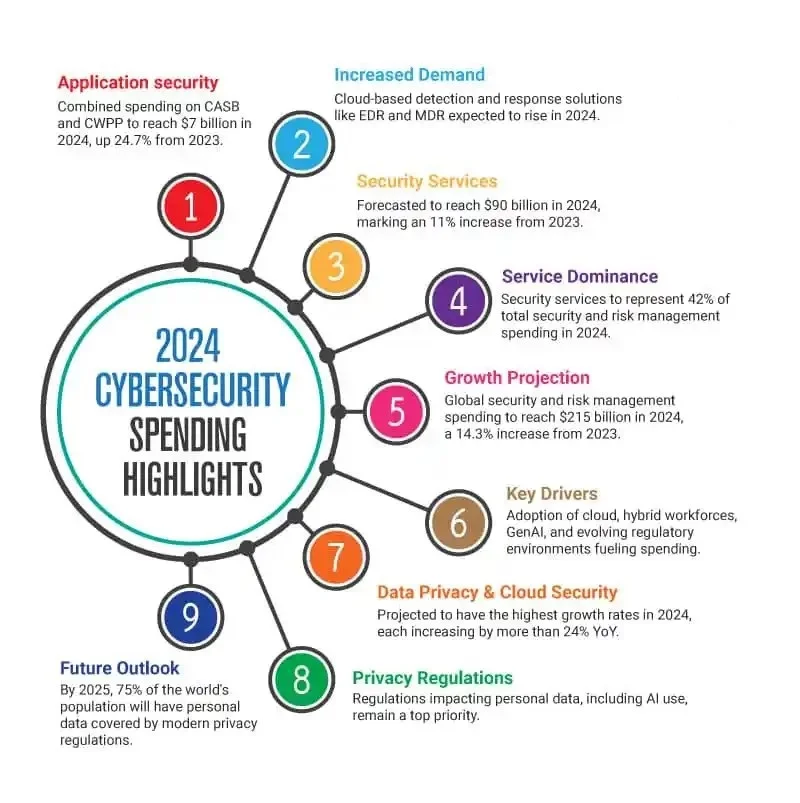Blogs
Home / Blog


As IT leaders gear up for the challenges and opportunities that 2024 brings, setting the right priorities is paramount. The rapidly evolving technological landscape demands a forward-thinking approach to budgeting and goal-setting. In this article, we will explore seven key priorities that IT leaders must consider as they plan for the upcoming year, ensuring a strategic and successful roadmap for their organizations.

Here are seven priorities IT leaders must set for 2024.
With cyber threats becoming more sophisticated, IT leaders need to make cybersecurity a top priority in 2024. Allocate IT budget and resources to implement advanced threat detection systems, conduct regular security audits, and invest in employee training programs. Adopting a proactive stance towards cybersecurity is crucial to safeguarding sensitive data and maintaining the trust of customers and stakeholders.

The cloud continues to be a driving force in IT infrastructure. IT leaders should focus on accelerating cloud adoption to enhance scalability, flexibility, and efficiency. Evaluate current workloads and identify opportunities to migrate to the cloud, optimizing costs and improving overall performance. Consider adopting a multi-cloud strategy to minimize risks and ensure resilience.

Data is a goldmine for organizations, and leveraging analytics is key to extracting meaningful insights. Allocate resources to enhance data analytics capabilities, including investing in advanced analytics tools and platforms. Develop a data-driven culture within the organization, fostering collaboration between IT and other departments. Utilize predictive analytics to make informed decisions and gain a competitive edge.Prioritizing AI and Automation
As artificial intelligence (AI) and automation technologies continue to mature, IT leaders should prioritize their integration into business processes. Identify areas where artificial intelligence and automation can streamline operations, reduce costs, and improve productivity. Allocate budget for AI-driven solutions that can enhance customer experiences and provide a competitive advantage in the market.
In today’s rapidly evolving business landscape, the strategic integration of artificial intelligence (AI) and automation technologies has become imperative for organizations seeking to stay ahead of the curve. IT leaders should prioritize the incorporation of these cutting-edge solutions across various business processes to unlock unparalleled efficiencies.

Streamlining operations through AI-driven automation not only reduces costs but also enhances overall productivity. Areas such as data analysis, routine task management, and decision-making processes can significantly benefit from the precision and speed that AI technologies offer.
Allocating budgetary resources to implement these solutions not only ensures a seamless workflow but also positions businesses to provide enhanced customer experiences, ultimately fostering a competitive advantage in the dynamic market. As artificial intelligence continues to mature, its seamless integration will not only transform internal operations but will also be a key driver of innovation and success in the ever-evolving business landscape.
The fast-paced evolution of technology demands a skilled workforce. IT leaders must prioritize investing in employee upskilling programs to ensure that their teams stay ahead of the curve. Identify emerging technologies relevant to your industry and provide training opportunities for your staff. This not only boosts employee morale but also strengthens the organization’s overall capabilities.
Read more: 7 Factors IT Leaders Must Consider When Hiring Managed Cloud Services
As an IT leader, investing in employee upskilling programs becomes not just a strategic choice but a necessity to navigate the ever-changing technological terrain. Technologies such as artificial intelligence, blockchain, edge computing, and quantum computing are progressively shaping the industry’s future. Providing training opportunities for staff in these domains not only enhances their IT skills but also ensures the organization remains adaptable and resilient.

Beyond mere skill development, fostering a culture of continuous learning can significantly boost employee morale, promoting a sense of engagement and commitment that ultimately strengthens the overall capabilities and innovation potential of the organization. In essence, the commitment to upskilling is an investment in both individual growth and the sustained success of the IT enterprise.
Sustainability is no longer just a buzzword; it’s a business imperative. IT leaders should prioritize implementing sustainable IT practices to reduce the environmental impact of their operations. Evaluate the energy efficiency of data centers, promote remote work to reduce carbon footprints, and consider eco-friendly technologies. Incorporating sustainability into IT strategies not only aligns with corporate social responsibility but also contributes to cost savings in the long run.
Read more: 5 Critical Functions of NIST Cybersecurity Framework Businesses Should Know About
The unexpected disruptions of the past few years have underscored the importance of robust business continuity and disaster recovery plans. IT leaders should allocate resources to strengthen these plans, ensuring minimal downtime in the face of unforeseen events. Regularly test and update recovery procedures, invest in redundant systems, and consider cloud-based disaster recovery solutions to enhance resilience.

As IT leaders prepare to set budgets and goals for 2024, these seven priorities should serve as a strategic guide. Embracing cybersecurity transformation, accelerating cloud adoption, enhancing data analytics capabilities, prioritizing artificial intelligence and automation, investing in employee upskilling, implementing sustainable IT practices, and strengthening disaster recovery and business continuity will position organizations for success in the dynamic digital landscape. By aligning these priorities with overall business objectives, IT leaders can pave the way for innovation, efficiency, and resilience in the years ahead.
Did this article help you set IT priorities for 2024? Share your feedback with us in the comments section below.
Enter your email to receive the latest news, updates and offers from HostNoc.
